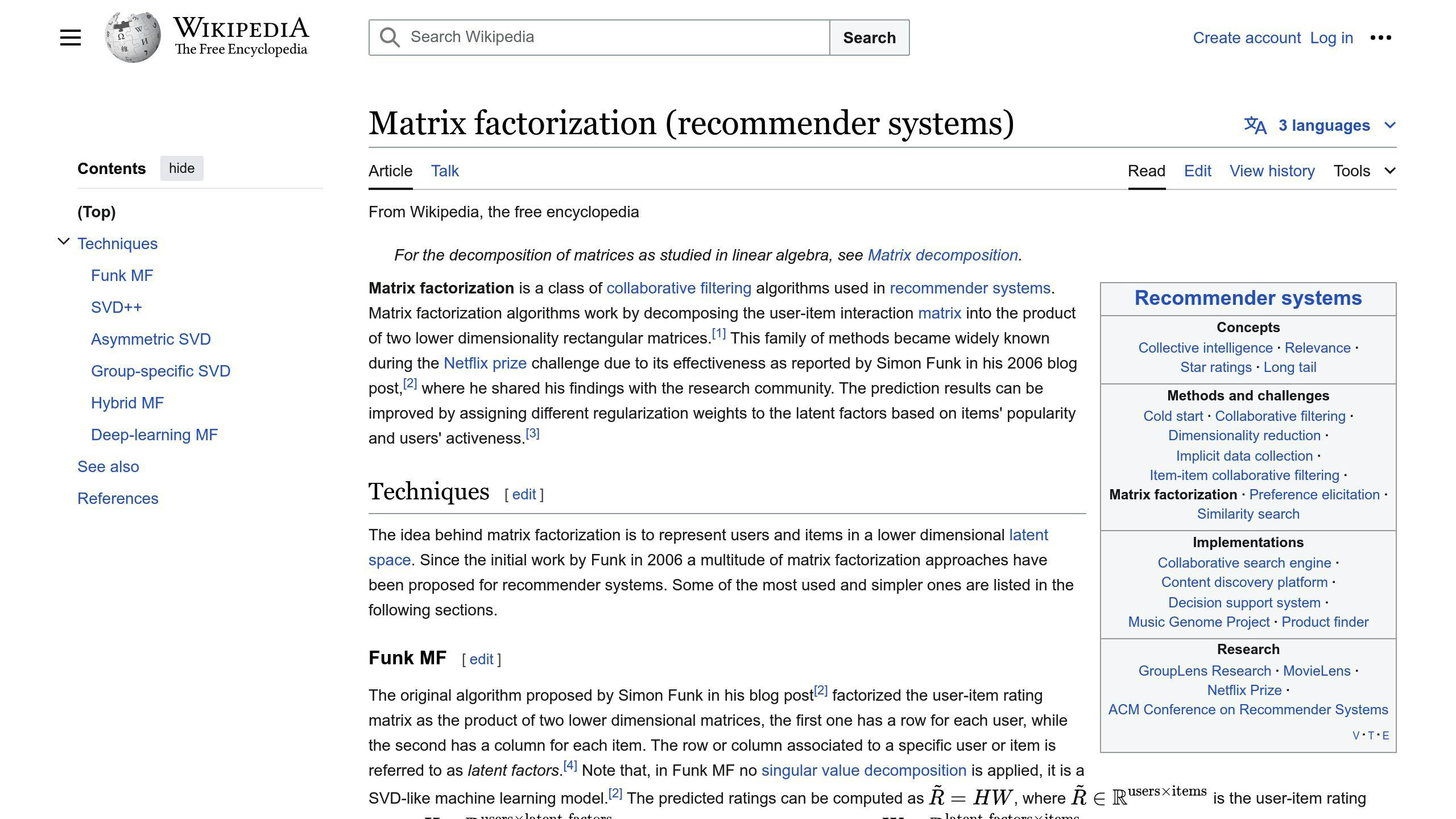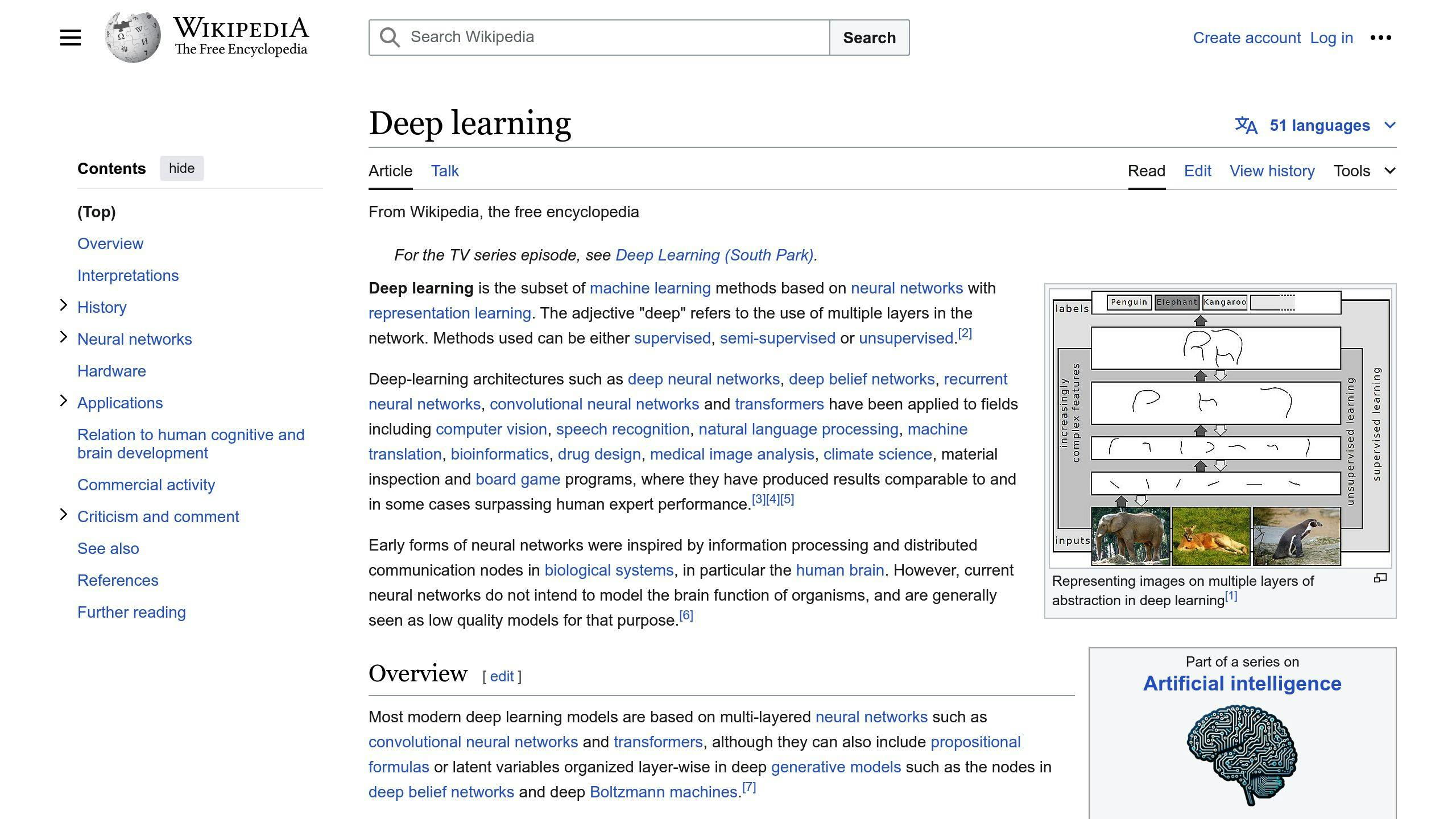Context-aware recommender systems provide personalized suggestions by considering factors like the user's location, time, activity, and preferences. By adapting recommendations to the current situation, these systems offer a more relevant and engaging experience.
Key Benefits:
- Accuracy: Tailored recommendations based on the user's context
- Improved User Experience: Personalized and relevant suggestions
- Versatility: Used across industries like e-commerce, entertainment, and healthcare
How Context is Incorporated:
- Pre-filtering: Selecting relevant data based on context before recommendations
- Post-filtering: Making recommendations first, then filtering based on context
- Direct Contextual Modeling: Including context directly in the recommendation algorithm
Techniques for Contextual Modeling:
| Technique | Description |
|---|---|
| Matrix Factorization | Identifies complex user-item-context relationships |
| Tensor Factorization | Handles higher-order user-item-context interactions |
| Deep Learning | Learns patterns and relationships using neural networks |
| Hybrid Approaches | Combines multiple techniques for improved accuracy |
Real-World Examples:
| Industry | Context Used | Example Recommendations |
|---|---|---|
| E-commerce | Browsing history, searches | Related products, frequently bought together |
| Entertainment | Viewing history, device type | Personalized TV shows and movies |
| Travel | Destination, dates, preferences | Customized itineraries and activities |
| Healthcare | Medical history, lifestyle | Treatment plans, medication |
Future Challenges:
- Handling dynamic and changing contexts in real-time
- Combining multiple contextual factors effectively
- Ensuring user privacy and transparency
- Improving recommendation interpretability
- Scaling systems for high data volumes and traffic
By addressing these challenges, context-aware recommender systems can continue to enhance user experiences with tailored and relevant suggestions across various domains.
Related video from YouTube
Understanding Context in Recommendation Systems
What is Context?
Context refers to the situation or circumstances surrounding a user when interacting with a recommendation system. It includes factors like:
- Location: Where the user is, such as their city or country.
- Time: The time of day, day of the week, or month.
- Activity: What the user is doing, like browsing, searching, or buying.
- Mood: The user's emotional state, like happy, sad, or neutral.
- Weather: The current weather conditions, like sunny, rainy, or cloudy.
Types of Contextual Data
Recommendation systems can use different types of contextual data:
| Type | Description |
|---|---|
| Location-based | User's geographical location |
| Time-based | Time of day, day of week, month |
| Activity-based | User's current task or action |
| Mood-based | User's emotional state |
| Weather-based | Current weather conditions |
Challenges with Contextual Data
Working with contextual data can be difficult due to:
- Data Quality: Data may be incomplete, inconsistent, or inaccurate.
- Privacy: Users may not want to share personal information.
- Scalability: Handling large amounts of data requires significant resources.
- Integration: Combining data from various sources is complex.
Approaches to Incorporate Context in Recommendations
There are three main ways to include context in recommender systems: pre-filtering, post-filtering, and direct contextual modeling. Each approach has its own strengths and weaknesses.
Pre-filtering with Context
Pre-filtering means selecting relevant data based on context before making recommendations. This works well when there is a lot of data, and not all of it is relevant to the user's current situation. For example, in a movie recommendation system, pre-filtering can select movies that match the user's location or time of day.
Pre-filtering techniques include:
- Contextual pre-filtering: Selecting data based on the user's location, time, or activity.
- Semantic pre-filtering: Selecting data based on the meaning of the context, like the user's mood or preferences.
Post-filtering with Context
Post-filtering means making recommendations first, then filtering them based on context. This is useful when the context is not available during the recommendation phase or when the context is complex.
Post-filtering techniques include:
- Contextual post-filtering: Filtering recommendations based on the user's location, time, or activity.
- Hybrid post-filtering: Combining multiple filtering techniques, like contextual and semantic filtering, to improve accuracy.
Direct Contextual Modeling
Direct contextual modeling means including context directly in the recommendation algorithm, rather than using pre-filtering or post-filtering. This works well when the context is complex and hard to model using traditional techniques.
Direct contextual modeling techniques include:
- Context-aware matrix factorization: Including context in the matrix factorization algorithm to improve accuracy.
- Context-aware neural networks: Using neural networks to model context and improve accuracy.
| Approach | Description | Pros | Cons |
|---|---|---|---|
| Pre-filtering | Select relevant data based on context before recommendations | Reduces data to process, improves accuracy | May not capture complex context relationships |
| Post-filtering | Make recommendations first, then filter based on context | Can handle complex context, improves accuracy | May not work for real-time recommendations |
| Direct Contextual Modeling | Include context directly in the algorithm | Can capture complex context, improves accuracy | May require a lot of data and computing power |
The choice of approach depends on the recommender system's needs and how complex the context is.
Techniques for Contextual Modeling
Context-aware recommender systems use various techniques to include context in the recommendation process. Here, we'll discuss four key techniques: matrix factorization, tensor factorization, deep learning, and hybrid approaches.
Matrix Factorization for Context

Matrix factorization is a popular technique used in context-aware systems. It breaks down the user-item interaction matrix into two smaller matrices, capturing the underlying factors of users and items. By including context in this process, matrix factorization can identify complex relationships between users, items, and contextual factors.
For example, in a movie recommendation system, matrix factorization can incorporate contextual information like time of day, location, or weather. This allows the system to provide personalized recommendations based on the user's current situation.
| Advantages | Disadvantages |
|---|---|
| Identifies complex user-item-context relationships | Can be computationally intensive |
| Provides personalized recommendations | May not perform well with sparse data |
Tensor Factorization for Context

Tensor factorization is an extension of matrix factorization, which can handle higher-order interactions between users, items, and contextual factors. This technique is useful when dealing with multi-dimensional contextual data, such as incorporating multiple contextual factors simultaneously.
Tensor factorization has been applied in various domains, including recommender systems, computer vision, and natural language processing. In context-aware recommender systems, tensor factorization can identify complex relationships between users, items, and multiple contextual factors, leading to more accurate recommendations.
| Advantages | Disadvantages |
|---|---|
| Can handle higher-order user-item-context interactions | Computationally intensive and requires large amounts of data |
| Provides more accurate recommendations | May overfit the data |
Deep Learning for Context

Deep learning techniques, such as neural networks and convolutional neural networks, are increasingly used in context-aware recommender systems. These techniques can learn complex patterns and relationships between users, items, and contextual factors, leading to more accurate recommendations.
Deep learning models can incorporate contextual information like text, images, or audio into the recommendation process. For example, in a music recommendation system, a deep learning model can analyze audio features and incorporate contextual information like user preferences and listening history.
| Advantages | Disadvantages |
|---|---|
| Can learn complex patterns and relationships | Requires large amounts of data and computational resources |
| Provides accurate recommendations | May overfit the data and require careful tuning |
Hybrid Approaches for Context
Hybrid approaches combine multiple techniques, such as matrix factorization, tensor factorization, and deep learning, to incorporate context into the recommendation process. These approaches can leverage the strengths of each technique, leading to more accurate and robust recommendations.
Hybrid approaches have been used in various domains, including recommender systems, natural language processing, and computer vision. In context-aware recommender systems, hybrid approaches can combine the strengths of different techniques, such as matrix factorization and deep learning, to provide more accurate and personalized recommendations.
| Advantages | Disadvantages |
|---|---|
| Combines strengths of multiple techniques | Can be computationally expensive and require careful tuning |
| Provides accurate and robust recommendations | May overfit the data and require large amounts of data |
sbb-itb-bc761f5
Evaluating Context-Aware Recommendation Systems
Checking how well context-aware recommender systems work is important to ensure they give accurate and personalized suggestions. Here, we'll discuss the different ways to measure their performance, the challenges involved, and how to compare these systems.
Measuring Performance
To evaluate how well these systems provide relevant recommendations in different situations, we use metrics like:
| Metric | What it Measures |
|---|---|
| Precision | The portion of recommended items that are relevant |
| Recall | The portion of relevant items that are recommended |
| F1-score | The balance between precision and recall |
| Context-aware metrics | How well the system accounts for contextual information |
Challenges in Evaluation
Evaluating context-aware recommender systems can be difficult due to:
- Complexity: These systems involve complex relationships between users, items, and contexts, making performance hard to measure.
- Data Sparsity: There may not be enough contextual data to properly evaluate the system in all situations.
- No Ground Truth: In many cases, there is no definitive "correct" answer to compare the recommendations against.
Comparing Evaluation Methods
Different evaluation methods have their own strengths and weaknesses. Here's a comparison:
| Method | Advantages | Disadvantages |
|---|---|---|
| Offline Evaluation | Fast and inexpensive | May not reflect real-world performance |
| Online Evaluation | Shows real-world performance | Time-consuming and resource-intensive |
| Hybrid Evaluation | Combines offline and online strengths | Can be complex to implement |
Real-World Uses of Context-Aware Recommendations
Context-aware recommender systems offer tailored suggestions across various fields, improving user experiences. Here are some real-world examples:
Online Shopping
Online retailers use context like browsing history, searches, and purchases to suggest relevant products. Amazon's "Frequently Bought Together" and "Customers Who Bought This Item Also Bought" are context-aware recommendations.
Entertainment
Services like Netflix use complex algorithms considering viewing history, searches, and device type to suggest personalized TV shows and movies.
Travel Planning
Travel websites use details like destination, dates, and preferences to suggest customized itineraries and activities for trip planning.
Healthcare
Healthcare providers can use medical history, genetic profiles, and lifestyle factors to recommend targeted treatment plans and medication.
Other Areas
Context-aware recommendations are also used in education (personalized learning paths), social networks (relevant content and connections), and more.
| Industry | Context Used | Example Recommendations |
|---|---|---|
| E-commerce | Browsing history, searches, purchases | Related products, frequently bought together |
| Entertainment | Viewing history, searches, device type | Personalized TV shows and movies |
| Travel | Destination, dates, preferences | Customized itineraries and activities |
| Healthcare | Medical history, genetics, lifestyle | Treatment plans, medication |
| Education | Learning progress, interests | Personalized learning paths, resources |
| Social Networks | Connections, interests, activity | Relevant content, new connections |
Future Directions and Challenges
As context-aware recommender systems keep growing, several difficulties and opportunities arise. In this section, we'll look at the future paths and challenges in developing and using these systems.
Handling Changing Contexts
One major challenge is dealing with dynamic and changing contextual information in real-time. As users' preferences and behaviors shift, the system must quickly adapt to provide relevant recommendations. This requires developing algorithms that can process and include new contextual data in real-time, ensuring the system remains accurate and effective.
Combining Multiple Contexts
Another challenge is combining multiple types of contextual information, such as location, time, and social networks. This requires techniques to combine and weigh the importance of different contextual factors, ensuring personalized recommendations that consider the user's complex and changing context.
Privacy and Ethics
As these systems collect and process sensitive and personal data, privacy and ethics become crucial. Developers must ensure the system is transparent, secure, and respects users' privacy, and that users have control over their data and preferences.
Improving Clarity
Context-aware recommender systems can be complex and hard to understand, making it challenging for users to trust and interpret the recommendations. Developing techniques to explain and visualize the recommendations, such as model clarity and transparency, can help improve user trust and satisfaction.
Scalability and Real-Time Performance
Finally, these systems must be able to scale and provide recommendations in real-time, even with large and diverse user bases. This requires developing efficient algorithms and architectures that can handle high volumes of data and traffic, ensuring the system remains responsive and effective.
| Challenge | Description |
|---|---|
| Handling Dynamic Contexts | Adapting to users' changing preferences and behaviors in real-time |
| Integrating Multiple Contexts | Combining and weighing different contextual factors like location, time, and social networks |
| Privacy and Ethics | Ensuring transparency, security, and user control over personal data |
| Improving Interpretability | Explaining and visualizing recommendations to improve user trust |
| Scalability and Real-Time Performance | Handling high volumes of data and traffic while remaining responsive |
Conclusion
Key Points
Context-aware recommender systems provide tailored suggestions based on a user's current situation. By considering factors like location, time, and activity, these systems offer more relevant recommendations. This article explored:
- What context-aware systems are and how they work
- The benefits over traditional recommendation systems
- Understanding different types of contextual data
- Approaches to incorporate context (pre-filtering, post-filtering, direct modeling)
- Techniques like matrix factorization, tensor factorization, and deep learning
- Evaluating system performance and challenges
- Real-world examples across industries like e-commerce, entertainment, and healthcare
- Future directions and potential issues like handling changing contexts and privacy
Final Thoughts
Context-aware recommendations enhance user experiences by providing personalized suggestions tailored to individual needs and situations. As these systems continue evolving, it's crucial to address challenges like:
- Adapting to dynamic, real-time contexts
- Combining multiple contextual factors effectively
- Ensuring user privacy and transparency
- Improving recommendation interpretability
- Scaling systems for high data volumes and traffic



